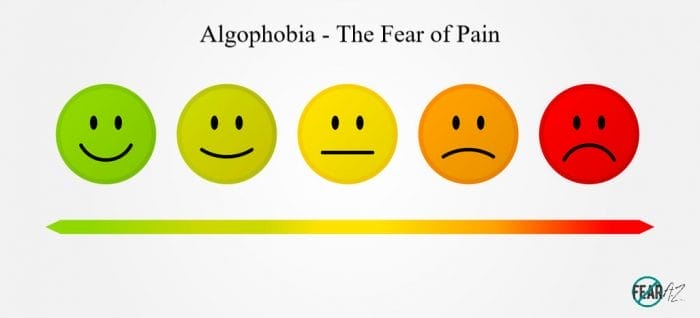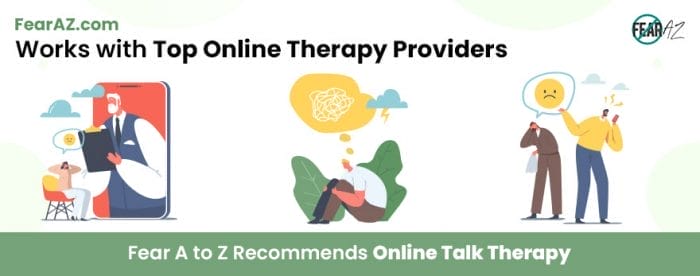Share This Article
Extreme Fear of Pain
Do you overreact whenever you experience the slightest of pain?
Sure, pain has the ability to scare people, but in your case, the distress you feel may be over the top. You’re aware that your reactions to pain are intense, but you can’t help it.
If this sounds familiar, you might have algophobia.
What Is Algophobia?
Fear is a normal reaction to pain, but for people with algophobia the dread they experience is deep and extreme to an extent that it can interfere with their daily life. They might not leave their home or engage in usual everyday activities for fear of coming across something that might cause them pain.
In severe cases, the mere thought of experiencing pain can trigger the condition. Sometimes, the condition can even lead to psychological pain, and this can turn into a vicious and debilitating cycle of pain and fear.

What Causes the Fear of Pain?
Mental health experts and behavioral psychologists suggest that most phobias, including algophobia, can be caused by genetic and environmental factors. For example, those who have a parent or relative dealing with algophobia have an increased risk of developing the phobia themselves.
Certain life experiences, especially traumatic events, could also cause phobias. For instance, let’s say during childhood you experienced an injury that caused you severe pain. This experience may have set in motion the development of your algophobia. People who have post-traumatic stress disorder (PTSD) may also have an increased risk of developing algophobia.
Quick Fact
What’s another name for algophobia?
The fear of pain is also known as algiophobia.
Symptoms of Algophobia
People with a fear of pain usually have symptoms that are similar to other phobias. These can be classified as physical symptoms and psychological symptoms. Some of these symptoms are as follows:
Physical Symptoms
- Breathlessness
- Nausea
- Dizziness
- Excessive sweating
- Increased heartbeat
- Headache
- Diarrhea
Psychological Symptoms
- Anxiety or panic attacks
- Extreme anger and loss of control
- Intense feelings of stress or terror
- The mental health of the person deteriorates rapidly
- Detachment from reality
- Inability to think and speak clearly
Self-help for Algophobia
The first thing you can do for yourself as an algophobic is to seek the advice of a professional psychologist or other mental health professional. This is the only proven way to learn skills which will help you cope with your fear. There are other steps, however, that you can take to help manage your phobia symptoms in conjunction with treatment.
The first self-help tip is to practice relaxation techniques. From yoga to massage to breath control, deliberately taking time to practice relaxation will help in the management of symptoms. It will help your mind relax and will decrease your level of anxiety. There are different forms of relaxation and not all work for everyone. It’s important to try out different styles to find the technique that works for you.
One popular relaxation method is transcendental meditation. This involves making vibrating sounds such as omm, which activates your vagus nerves. This can slow down your heart rate and immediately produce a calming effect.
If your algophobia is a result of pre-existing conditions such as arthritis, the progressive muscle relaxation technique is one that might do wonders for you. It involves a repeated cycle of tensing and releasing the muscles of your body from your feet up to your neck. Contract and relax the muscles slowly and repeatedly, focusing all your attention solely on the process. This is an excellent self-help therapy.
Another helpful technique is visualization. This means mentally visualizing that you are successfully handling a situation that involves pain. Your mind is at the center of all your fears and anxieties and so to help yourself, you must first convince your mind that you are capable of handling pain and discomfort. Hence, the first step is to visualize it, and then move on towards gradually achieving it.
Positive visualization also comes in handy. This is particularly helpful when you are trying to avoid intrusive thoughts and fears that seep into your mind and exaggerate your fears or triggers. One common method is to visualize someone standing at the door, shouting all these scary possibilities at you. This makes you want to avoid your triggers, and you visualize yourself closing the door on them and putting an end to their fear mongering.
You can also try to join group therapies and even reach out to people with similar phobias and symptoms. Knowing that you are not alone and that you are a part of a community of similar people will do wonders for your confidence in overcoming your phobia. Online communities, group chats, physical sessions with a moderator, all these have been known to help phobia sufferers cope with their depression and isolation symptoms that come with the condition.
Professional Help for Algophobia
Some of the available treatments proven to be useful are as follows:
Cognitive Behavioral Therapy (CBT)
CBT is a psychotherapy that uses a practical approach to treating anxiety and other similar disorders, but it is also proven to be useful in treating phobias.
CBT focuses on changing negative thoughts and ideas that trigger the condition. In the case of algophobia, the therapist uses a structured approach to help patients realize how their thoughts and perceptions are triggering their phobia. The aim is to teach the patient to view their object of fear more clearly and develop ways to respond to it productively.
Cognitive-behavioral therapy is rooted in five key principles:
- There is always another point of view.
- Events don’t cause feelings.
- We all have unique ways of seeing the world.
- Mind affects the body; body affects the mind.
- Our minds are scientific.
All these principles, once well understood by the patient, can help them approach their triggers and symptoms from a more informed and balanced mental state.
Systematic Desensitization
Also known as exposure therapy, this is another useful method in which the patient is gradually exposed to the object of fear until they become desensitized and no longer have visceral reactions towards it. There are two ways of performing this procedure: in vitro or in vivo. In vitro involves the patient visualizing being exposed to the trigger while in vivo means that the patient is physically placed in contact with a stimulus. This is done in controlled measures under supervision of a mental health professional. It’s important to avoid extreme reactions where the patient is overexposed and may experience negative consequences.
How to Overcome the Fear of Pain
- The first step is understanding how your phobia works. Then take steps to overcome it.
- When you experience pain, try deep calming breaths to slow down your heart rate and prevent your panic from getting the better of you.
- You can’t fight this on your own. Open up to your friends and family about how algophobia has affected your life. Let them help you get through it.
- You can’t beat the phobia by locking yourself away and distancing yourself from the world. Go out and live your life. Strive to fight your fear.
Work through the Fear of Pain
Many self-help tips and professional therapies work hand in hand. Meditation and relaxation techniques help the patient through the desensitization stage of their professional therapy, and positive visualization is quite similar to the in vitro systematic desensitization technique.
All in all, it’s important to remember that overcoming the fear of pain is possible. The first step is always the most difficult. But with commitment and the right support from the people you trust or an expert medical provider (or both), you can break free from the grip of algophobia and enjoy your life.




